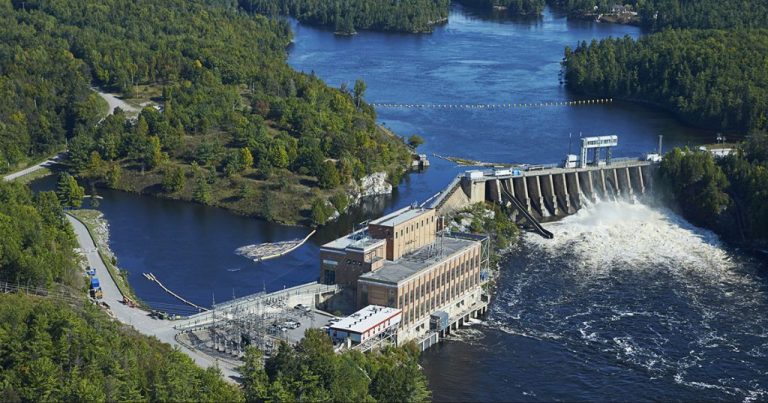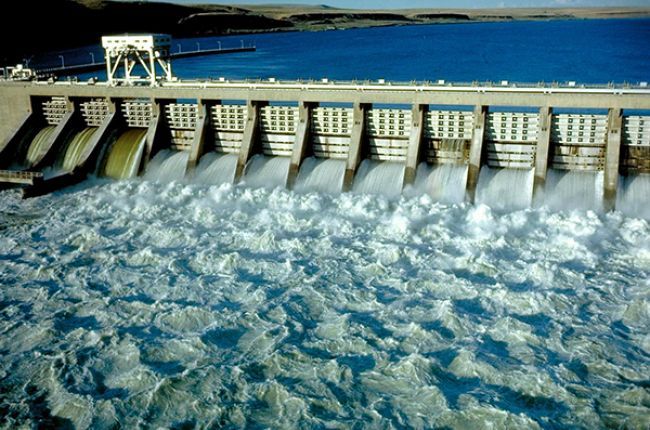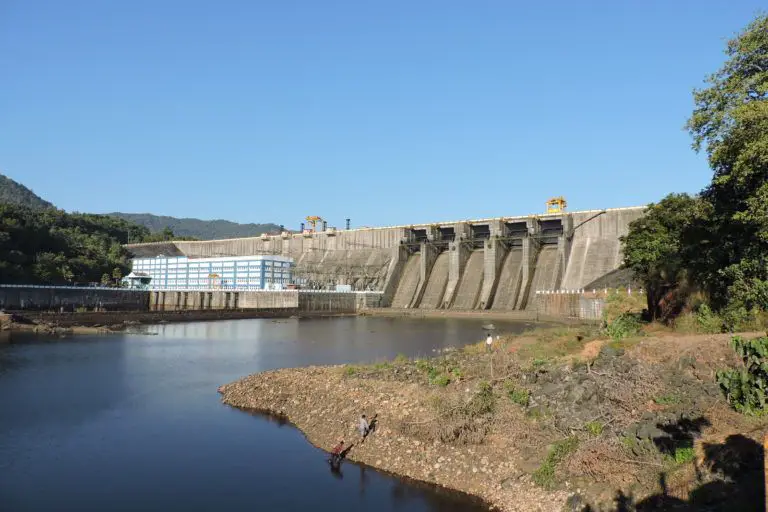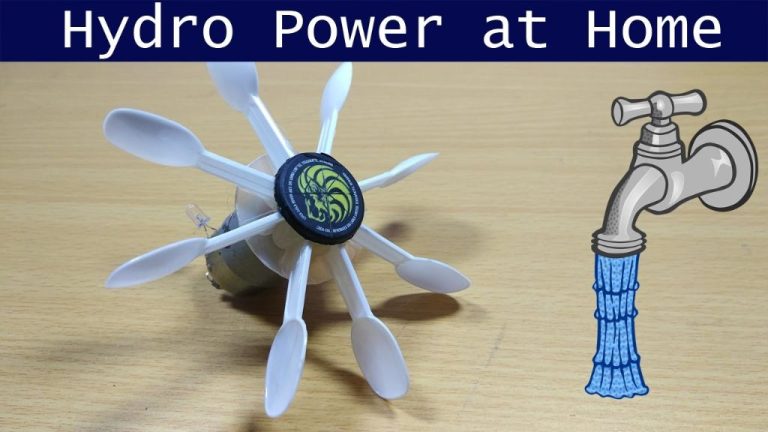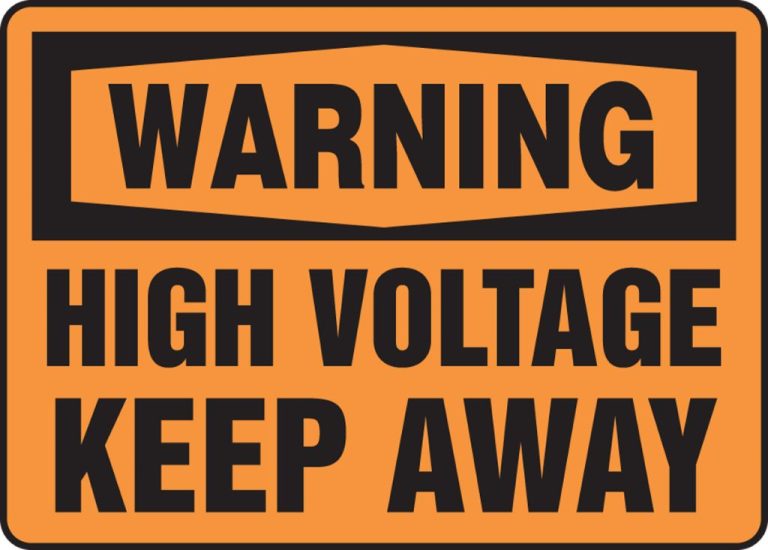Is Hydropower Kinetic Energy?
What is Hydropower?
Hydropower is a type of renewable energy that utilizes the natural flow of water to generate electricity. It converts the kinetic energy present in moving water into mechanical energy by using a turbine connected to a generator. The spinning turbine activates the generator to produce electrical power. Essentially, hydropower harnesses the energy of falling or fast-moving water to create electricity.
According to the Merriam-Webster dictionary, hydropower is defined as “hydroelectric power” (1). It is a form of energy that relies on the movement of water to drive the turbines rather than using steam, gas, wind, or solar. The Oxford dictionary further defines hydropower as “electricity produced from machines that are run by moving water” (2). The key aspect is utilizing water’s kinetic energy for generating power.
In summary, hydropower is a renewable energy source that converts the kinetic energy of flowing or falling water into electricity using hydropower turbines and generators. It is one of the oldest and most widely used forms of renewable energy.
Sources:
(1) https://www.merriam-webster.com/dictionary/hydropower
(2) https://www.dictionary.com/browse/hydropower
How Hydropower Works
Hydropower works by using the kinetic energy in flowing water to generate electricity. Water in a reservoir behind a dam flows through the dam and turns a turbine connected to a generator. The flowing water causes the turbine blades to spin, which then spins a shaft connected to a generator. The generator converts the mechanical energy from the spinning shaft into electrical energy through electromagnetic induction1. The electricity is then transported via power lines to homes, businesses, and other consumers2.
The amount of electricity that can be generated depends on the volume of water flow and the vertical drop or “head” of the water. More flow and more head produces more electricity. Dams are built to increase the head and control water flow.
Kinetic Energy
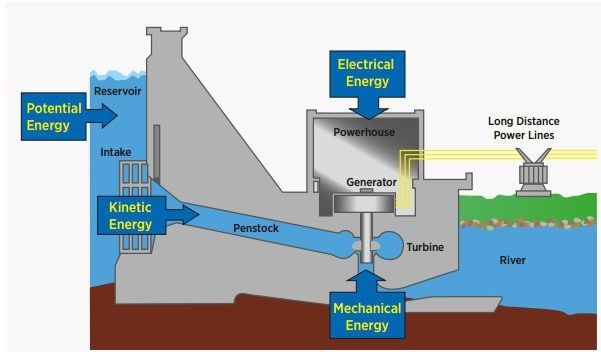
Kinetic energy is defined as the energy an object possesses due to its motion. The word “kinetic” comes from the Greek word “kinetikos” meaning “motion.” Kinetic energy depends on the mass and velocity of an object and is directly proportional to both. The faster an object moves, the more kinetic energy it possesses. Kinetic energy is one form of mechanical energy and is present in all moving objects, from a rolling ball to a flying airplane.
According to the Merriam-Webster dictionary, kinetic energy is “energy associated with motion.” https://www.merriam-webster.com/dictionary/kinetic%20energy The kinetic energy of an object increases as its speed increases. How much kinetic energy an object has also depends on its mass – heavier objects require more force to accelerate them and therefore possess more kinetic energy at high speeds.
The kinetic energy of an object is mathematically calculated as KE = 1/2mv^2, where m is the object’s mass and v is its velocity. This shows that doubling an object’s velocity quadruples its kinetic energy, while doubling mass only doubles the kinetic energy. Kinetic energy is directly proportional to both mass and the square of velocity.
Hydropower Utilizes Kinetic Energy
When flowing water is captured and turned into electricity, it is harnessing the kinetic energy of the moving water. Kinetic energy is the energy of motion. In the case of hydropower, the most common type utilizes the energy of falling or fast-moving water to spin a turbine and generator to produce electricity.
As water flows, it gains kinetic energy due to its motion. The faster the flow, the more kinetic energy it possesses. When the water falls from higher elevations or through dams, it accelerates and increases its kinetic energy. Hydropower projects are often built to take advantage of water with high kinetic energy from natural falls or released dams. The kinetic energy of falling water is converted to rotational kinetic energy to spin turbines.
The key principle is that the kinetic energy of moving water causes turbine blades to rotate just like how wind causes turbine blades in wind power to rotate. The turbine is connected to a generator so that the rotational motion spins magnets within wire coils to induce a current – thereby generating electricity. In this way, hydropower directly harnesses the kinetic energy of falling or fast-flowing water.
Sources:
https://openei.org/wiki/Hydropower/STEM/Resources/Educator_Resources
Amount of Energy
The amount of energy generated from hydropower depends on the volume and speed of the falling water. The potential energy stored in the water is converted into kinetic energy as it falls, which then rotates the turbines to generate electricity. According to a study by Alashan (2017), the energy produced can be calculated using the following formula:
Energy (kWh) = 9.81 x Head (m) x Flow Rate (m3/s) x Plant Efficiency
Where head refers to the height difference between the water intake and turbine location. The greater the volume of water and height from which it falls, the more electricity can be generated. Large hydropower facilities can have massive dams and water reservoirs to increase the head and flow rate. For example, the Three Gorges Dam in China has a height of 185 m and utilizes the flow rate of the Yangtze River to generate 22,500 MW of power (Alashan, 2017).
Hydropower Projects
Hydropower projects utilize flowing water to generate electricity. The key components of a hydropower project include:
Dam and Reservoir – A dam is constructed to store river water in a reservoir. The dam height and reservoir size determines the amount of water available for power generation.
Turbines – Hydropower turbines convert the kinetic energy of falling water into mechanical energy. Common turbine types used are Kaplan, Francis and Pelton wheels.
Penstock – A penstock is a closed conduit that delivers water from the reservoir to the turbines.
Generator – The turbine spins a generator to produce electricity. The electricity is then transmitted via power lines to homes and businesses.
Additional components can include spillways, fish ladders, and powerhouses.
Hydropower Capacity
Hydropower facilities in the United States have an installed capacity of over 80,000 megawatts (MW) as of 2020, generating around 7% of total U.S. electricity generation. The top five states for hydropower capacity are Washington, California, Oregon, New York and Alabama. Globally, hydropower capacity reached 1,308 gigawatts (GW) in 2020. China has the most installed hydropower capacity in the world at over 352 GW, followed by Brazil, Canada, the U.S. and Russia.
The Three Gorges Dam in China is the world’s largest hydroelectric power station with a capacity of 22,500 MW, supplying around 100 billion kWh annually. Other major facilities include the Itaipú Dam on the Brazil/Paraguay border at 14,000 MW and the Guri Dam in Venezuela at 10,200 MW. The Grand Coulee Dam in Washington state is the largest U.S. hydropower facility with 6,809 MW capacity. Most large-scale hydropower projects generate hundreds or even thousands of megawatts of electricity. [2]
In total, hydroelectric dams worldwide produce over 4,000 terawatt-hours of electricity each year. The immense generating capacities of these facilities demonstrate the potential of hydropower to meet electricity demands in a renewable manner when implemented properly and responsibly.
Hydropower Pros and Cons
Hydropower is considered a renewable energy source because it relies on the water cycle to generate electricity. Once a hydroelectric dam is built, it can continue producing electricity for decades, making it a reliable source of energy. However, hydropower does have some downsides when it comes to environmental impacts.
On the pros side, hydropower does not directly produce air pollution or greenhouse gases. It’s also very flexible – hydropower plants can start up and stop quickly to meet shifts in electricity demand. In addition, the reservoirs created by hydroelectric dams offer recreation opportunities like boating and fishing.
In terms of cons, constructing large dams disrupts natural waterways and wildlife habitats. Fish and other aquatic life can be injured or killed by passing through hydroelectric turbines. Dams block migrating fish routes and alter downstream water temperatures and flow patterns. Large reservoirs created by dams also flood large areas of land to create artificial lakes.
Overall, hydropower is a proven renewable technology that provides reliable electricity. However, the impacts to local ecosystems must be carefully managed. Fish ladders, fish screens, and minimum water flow requirements help mitigate damages to wildlife caused by hydropower dams.
Growth of Hydropower
The amount of energy produced from hydropower has steadily increased over the past 50 years. According to the International Energy Agency, global hydropower generation capacity has more than doubled since 1970, going from around 700 TWh in 1970 to over 4,300 TWh in 2019 (IEA). This represents an average annual growth rate of around 3%.
The countries with the most installed hydropower capacity have also seen significant growth. For example, China’s installed capacity has grown from around 25 GW in 1980 to over 350 GW as of 2020 – making it by far the largest producer of hydropower in the world (Statista). Other top hydropower countries like Brazil, Canada, and India have also increased their capacity substantially in recent decades.
Several factors have driven the increased deployment of hydropower globally, including rising electricity demand, favorable policies, technology improvements, and the need for clean renewable energy. According to IEA projections, global hydropower generation could grow another 60% by 2040 under current policy scenarios.
Future of Hydropower
Hydropower is expected to continue playing a major role in renewable energy generation in the United States. According to a report by the Department of Energy, hydropower could grow from 101 GW of capacity in 2015 to nearly 150 GW by 2050.
New technologies and innovation will help drive hydropower’s future growth. Upgrades and retrofits to existing infrastructure can increase generation capacity. Developing new stream-reach hydropower that taps energy from free-flowing rivers, as well as new pumped storage hydropower, can also expand capacity. According to the DOE report, stream-reach hydropower alone could grow nearly 50% by 2050.
Hydropower’s ability to provide flexible, on-demand renewable energy will become increasingly valuable as more variable resources like wind and solar come online. With the ability to ramp up and down quickly, hydropower can balance the grid and complement other renewables. This flexibility, along with hydropower’s low operating costs, make it an integral part of the nation’s clean energy future.
Sources:

